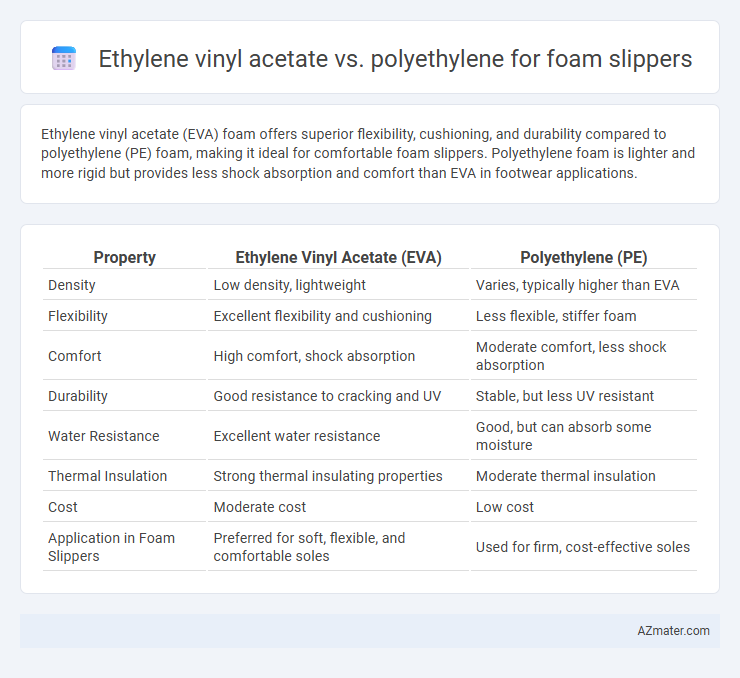Ethylene vinyl acetate (EVA) foam offers superior flexibility, cushioning, and durability compared to polyethylene (PE) foam, making it ideal for comfortable foam slippers. Polyethylene foam is lighter and more rigid but provides less shock absorption and comfort than EVA in footwear applications.
Table of Comparison
| Property | Ethylene Vinyl Acetate (EVA) | Polyethylene (PE) |
|---|---|---|
| Density | Low density, lightweight | Varies, typically higher than EVA |
| Flexibility | Excellent flexibility and cushioning | Less flexible, stiffer foam |
| Comfort | High comfort, shock absorption | Moderate comfort, less shock absorption |
| Durability | Good resistance to cracking and UV | Stable, but less UV resistant |
| Water Resistance | Excellent water resistance | Good, but can absorb some moisture |
| Thermal Insulation | Strong thermal insulating properties | Moderate thermal insulation |
| Cost | Moderate cost | Low cost |
| Application in Foam Slippers | Preferred for soft, flexible, and comfortable soles | Used for firm, cost-effective soles |
Introduction to Foam Slipper Materials
Ethylene vinyl acetate (EVA) offers superior cushioning, flexibility, and durability compared to polyethylene (PE), making it a preferred choice for foam slipper soles. EVA foam provides enhanced shock absorption and lightweight comfort, key features for everyday wear and prolonged use in slippers. Polyethylene foam, while cost-effective and moisture-resistant, typically lacks the elasticity and resilience found in EVA, resulting in a firmer and less comfortable slipper experience.
What is Ethylene Vinyl Acetate (EVA)?
Ethylene Vinyl Acetate (EVA) is a flexible, durable copolymer made from ethylene and vinyl acetate, widely used in foam slippers due to its excellent cushioning, lightweight nature, and shock absorption properties. EVA foam provides better elasticity and resilience compared to traditional polyethylene foam, enhancing comfort and support for prolonged wear. Its closed-cell structure also offers superior water resistance and insulation, making EVA the preferred material for high-quality, durable foam slippers.
Understanding Polyethylene (PE) Foam
Polyethylene (PE) foam offers superior durability and cushioning compared to Ethylene Vinyl Acetate (EVA) for foam slippers, making it ideal for long-lasting comfort and impact absorption. With closed-cell structure, PE foam provides excellent water resistance and thermal insulation, enhancing slipper performance in various environments. Its lightweight and high tensile strength contribute to better foot support and prolonged wear in everyday use.
Key Differences between EVA and PE
Ethylene vinyl acetate (EVA) foam offers superior elasticity, cushioning, and flexibility compared to polyethylene (PE) foam, making it ideal for high-comfort foam slippers. EVA's closed-cell structure provides better shock absorption and durability, whereas PE foam is typically stiffer and less resilient under repeated pressure. EVA foam is also more resistant to UV radiation and environmental stress cracking, enhancing longevity in footwear applications.
Comfort and Cushioning Comparison
Ethylene vinyl acetate (EVA) foam slippers offer superior cushioning and flexibility due to their closed-cell structure, providing enhanced shock absorption and long-lasting comfort. Polyethylene foam, while lightweight and durable, tends to be firmer and less resilient, resulting in reduced cushioning and potential discomfort during extended wear. The softness and elasticity of EVA make it the preferred material for foam slippers focused on superior comfort and foot support.
Durability and Longevity in Foam Slippers
Ethylene vinyl acetate (EVA) foam slippers offer superior durability and resistance to cracking compared to polyethylene (PE) foam, making them ideal for long-term use. EVA's inherent flexibility and cushioning properties maintain structural integrity under prolonged wear, while PE foam tends to compress and degrade faster. This enhanced longevity makes EVA foam slippers a preferred choice for consumers seeking durable and comfortable footwear.
Water Resistance and Hygiene Factors
Ethylene vinyl acetate (EVA) offers superior water resistance compared to polyethylene (PE), making EVA foam slippers more suitable for wet environments and reducing moisture absorption that can lead to odor and bacterial growth. EVA's closed-cell structure enhances hygiene by preventing water retention and the buildup of fungi and bacteria, whereas polyethylene's more porous composition may trap moisture and compromise cleanliness. Choosing EVA foam slippers ensures a longer-lasting, hygienic product with better resistance to water-related wear and microbial contamination.
Environmental Impact: EVA vs PE
Ethylene vinyl acetate (EVA) foam slippers exhibit lower environmental impact due to their recyclability and reduced carbon footprint compared to polyethylene (PE) foam slippers, which are less biodegradable and often contribute more to microplastic pollution. EVA production typically consumes less energy and emits fewer greenhouse gases, while PE foam slippers are derived from non-renewable petroleum sources with higher ecological toxicity. Disposal challenges of PE foam include slow degradation rates and persistence in landfills, whereas EVA's chemical structure allows for more efficient recycling processes and better environmental compatibility.
Cost and Manufacturing Considerations
Ethylene vinyl acetate (EVA) foam offers greater flexibility and cushioning compared to polyethylene (PE), but typically comes at a higher raw material cost, impacting overall slipper production expenses. Manufacturing EVA foam requires precise temperature control during molding to maintain its softness and durability, while PE foam processes are generally simpler and faster, reducing labor and processing costs. The choice between EVA and PE foam hinges on balancing budget constraints with desired comfort and performance qualities in foam slippers.
Which Material is Best for Foam Slippers?
Ethylene vinyl acetate (EVA) is favored for foam slippers due to its superior cushioning, flexibility, and lightweight properties, providing enhanced comfort and shock absorption compared to polyethylene (PE). Polyethylene foam tends to be denser and less resilient, often resulting in stiffer, less comfortable slippers with lower durability over time. For optimal foam slipper performance, EVA's elasticity and moisture resistance make it the best choice for prolonged wear and comfort.

Infographic: Ethylene vinyl acetate vs Polyethylene for Foam slipper
 azmater.com
azmater.com